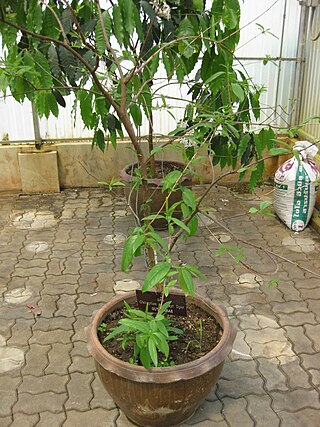
Cratoxylum arborescens is a plant in the family Hypericaceae. The specific epithet arborescens is from the Latin meaning "tree-like".

Cratoxylum maingayi is a plant in the family Hypericaceae. It is named for the botanist Alexander Carroll Maingay.
Alangium longiflorum is a tree in the dogwood family Cornaceae. The specific epithet longiflorum is from the Latin meaning "long flowers".

Anisophyllea is a genus of plant in the family Anisophylleaceae. The generic name is from the Greek meaning "unequal leaf", referring to the dimorphism of the leaves.
Anisophyllea corneri is a tree of tropical Asia in the family Anisophylleaceae. It is named for the English botanist Edred John Henry Corner.
Anisophyllea ferruginea is a tree of Borneo in the family Anisophylleaceae. The specific epithet ferruginea is from the Latin meaning "rust-coloured", referring to the leaf hairs.
Cassine viburnifolia is a species of mangrove plant of tropical Asia in the staff vine family Celastraceae. The specific epithet viburnifolia refers to how the plant's leaves resemble those of the genus Viburnum.

Kandelia candel is a species of mangrove in the family Rhizophoraceae, found around the coasts of South Asia and Southeast Asia, from western India to Borneo. Populations further east, from Vietnam to Japan were formerly included in K. candel, but are now considered a separate species, K. obovata.

Bruguiera is a plant genus in the family Rhizophoraceae. It is a small genus of five mangrove species and three hybrids of the Indian and west Pacific Ocean region, its range extending from East Africa and Madagascar through coastal India, Sri Lanka and Southeast Asia to northern Australia, Melanesia and Polynesia. It is characterised by calyces with 8-16 lanceolate, pointed lobes, 16-32 stamens, explosive release of pollen, and viviparous propagules. It is named in honour of French explorer and biologist Jean Guillaume Bruguière (1750–1798). Recently, the eighth taxa of Bruguiera, B. × dungarra was recognised as occurring in northern Australia.

Xylocarpus granatum, commonly known as the cannonball mangrove, cedar mangrove, or puzzlenut tree, is a species of mangrove in the mahogany family (Meliaceae). It is found in Africa, Asia, Australasia and the Pacific Islands. It is a common species of mangrove, and the International Union for Conservation of Nature has assessed its conservation status as being of "least concern".
Mangifera decandra is a species of mango trees in the genus Mangifera. It was described by Ding Hou in 1972.

Ceriops tagal, commonly known as spurred mangrove or Indian mangrove, is a mangrove tree species in the family Rhizophoraceae. It is a protected tree in South Africa. The specific epithet tagal is a plant name from the Tagalog language.

Xylocarpus moluccensis is a tree in the family Meliaceae. It is named for the Moluccas archipelago.
Perrottetia alpestris subsp. philippinensis is a subspecies of Perrottetia alpestris. It is a plant in the family Dipentodontaceae, sometimes classified in the family Celastraceae.

Bruguiera parviflora is a tree in the family Rhizophoraceae. The specific epithet parviflora is from the Latin meaning "small flowers".

Rhizophora stylosa, the spotted mangrove, red mangrove, small stilted mangrove or stilt-root mangrove, is a tree in the family Rhizophoraceae. The specific epithet stylosa is from the Latin meaning "stylus form", referring to the flower.

Sonneratia alba is a mangrove tree in the family Lythraceae. The specific epithet alba is from the Latin meaning "white", referring to the flowers.
Gluta rugulosa is a tree of Borneo in the cashew and sumac family Anacardiaceae. The specific epithet rugulosa is from the Latin meaning "wrinkled", referring to the fruits.
Gluta sabahana is a tree of Borneo in the cashew and sumac family Anacardiaceae. The specific epithet sabahana is from the Latin meaning "of Sabah".

Ceriops australis, the yellow mangrove or smooth-fruited yellow mangrove, is a species of mangrove in the family Rhizophoraceae, native to tropical northern Australia and southern New Guinea. It is a common species in the region and although mangroves are threatened by habitat destruction and climate change, the International Union for Conservation of Nature has assessed its conservation status as being of "least concern".













